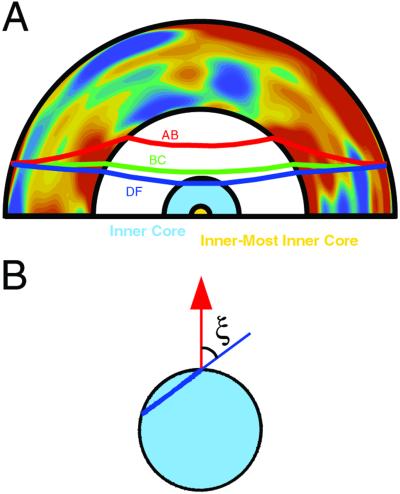Fig 1.
Geometry of ray paths for PKP branch. (A) Ray paths for PKPAB (red curve), PKPBC (green curve), and PKPDF or PKIKP (blue curve) at an epicentral distance of 150°. PKPBC (BC for brevity) and PKPAB (AB) turn in the lower and upper outer core, respectively, and do not sample the inner core. Travel times of PKPDF (DF) are referred to as “absolute travel times” in contrast to “differential travel times,” which are obtained by subtracting DF travel times from BC (BC − DF) or AB (AB − DF) travel times. Differential travel times are often used in inner-core studies because similarity of the BC or AB path with DF path within the mantle reduces undesirable mantle and earthquake effects from the data. Mantle heterogeneity based on a shear-velocity model of Gu et al. (13) is plotted. Red colors indicate slower than average velocity, and blue colors indicate faster than average velocity. The cross section is made along a great circle between Africa and the southwestern Pacific (crossing under Eurasia). (B) Geometry of the DF ray in the inner core (pale-blue circle), where ξ is the angle of the ray with respect to the symmetry axis (shown in red). At high values of cos2ξ, the ray is traveling parallel to the symmetry axis, and when cos2ξ is small, the ray is traveling perpendicular to the symmetry axis.

